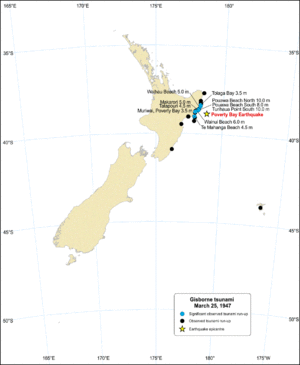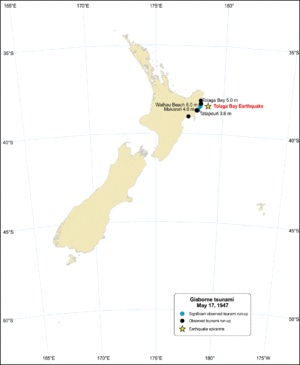1947 Gisborne earthquakes and tsunami facts for kids
The 1947 Gisborne earthquakes and tsunami were two powerful natural events that happened near Gisborne, New Zealand. They both caused huge ocean waves called tsunamis. These events took place off the coast of New Zealand's North Island.
Contents
The First Big Shake and Wave
The first earthquake happened on March 26, 1947, at 8:32 AM. It struck offshore from Poverty Bay. Even though it felt like a small shake in Gisborne, it was actually very strong, measuring about 7.0 to 7.1 on the moment magnitude scale.
This earthquake created a massive tsunami. The biggest wave reached a height of 10 metres (about the height of a three-story building!) when it hit the land. This huge wave crashed onto the coast from Mahia Peninsula to Tokomaru Bay.
What Happened When the Wave Hit
About 30 minutes after the earthquake, the tsunami swamped the coast between Muriwai and Tolaga Bay. This tsunami was only seen in New Zealand.
At the Tatapouri Hotel, four people saw the giant wave coming. They quickly ran up a nearby hill to safety. Two waves crashed through the hotel's ground floor, reaching as high as the windowsills. As the water pulled back, it washed small buildings out to sea.
A little further north, at Turihaua, a 10-metre wave hit a small cottage. Two men who were outside were swept inland onto the coast road. Three other people inside the kitchen were trapped as water filled the room up to their heads. When the water pulled back, it destroyed most of the cottage, leaving only the kitchen.
The Pouawa River bridge, which was a bit further north, was swept 800 metres inland by the powerful water. Later, seaweed was found stuck in telegraph wires 12 metres above sea level at Pouawa Beach. At Mahanga Beach, a house was even moved off its foundations by the force of the waves.
The Second Event and Its Impact
Seven weeks later, on May 17, a second earthquake struck offshore from Tolaga Bay. This one was also very strong, estimated to be about 6.9 to 7.1 on the moment magnitude scale.
This second earthquake also created a tsunami. This wave was smaller than the first, reaching a maximum height of 6 metres. It happened during low tide, which helped reduce its power.
Damage and Lucky Escapes
Even though it was less powerful, this tsunami caused some damage along the east coast. It's remembered for washing away construction materials that were being used to fix the damage from the first tsunami.
Luckily, no one died in either of these tsunamis. However, if these huge waves had hit during the summer holidays when beaches were full of people, the outcome could have been much worse.
Why These Events Happened
New Zealand sits on the edge where two of Earth's giant plates meet. These are the Indo-Australian Plate and the Pacific Plate. Think of these plates as huge pieces of a puzzle that make up the Earth's outer layer.
In the North Island, these plates are constantly moving. Most of this movement happens along something called the Hikurangi Subduction Zone. This is where one plate slides underneath another.
Both the 1947 earthquakes are believed to have happened along this Hikurangi Subduction Zone. They were very close to each other. The tsunamis were caused by a sudden release of energy from the Earth's crust as these plates moved.
Because the tsunamis were unusually large compared to how much the ground shook, these events are known as "tsunami earthquakes." This means the earthquake itself might not feel super strong, but it can still create a very big and dangerous wave.



